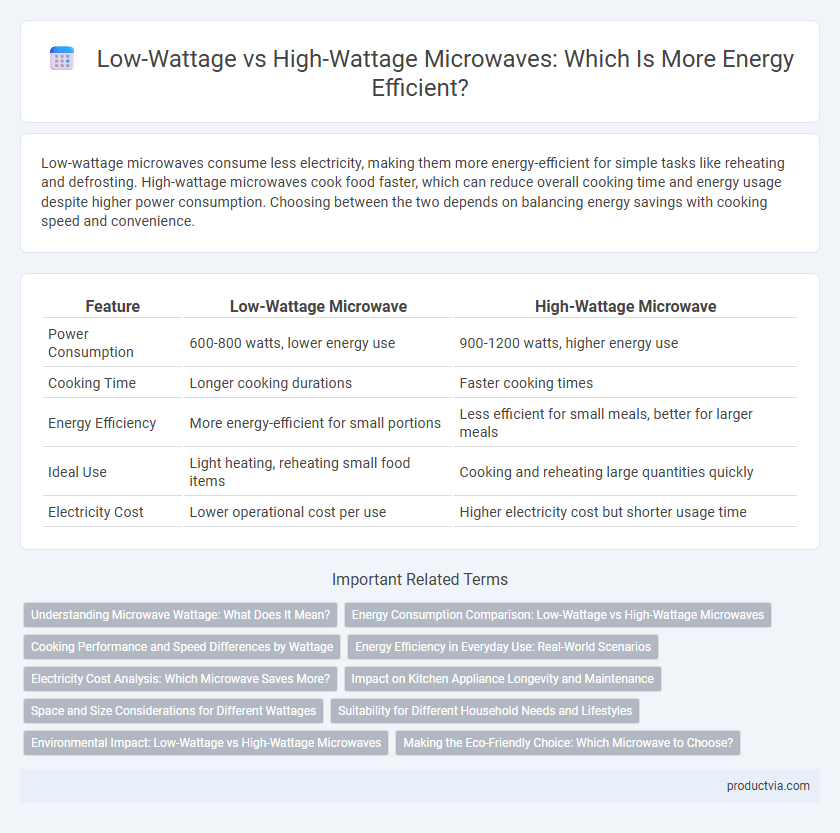Low-wattage microwaves consume less electricity, making them more energy-efficient for simple tasks like reheating and defrosting. High-wattage microwaves cook food faster, which can reduce overall cooking time and energy usage despite higher power consumption. Choosing between the two depends on balancing energy savings with cooking speed and convenience.
Table of Comparison
| Feature | Low-Wattage Microwave | High-Wattage Microwave |
|---|---|---|
| Power Consumption | 600-800 watts, lower energy use | 900-1200 watts, higher energy use |
| Cooking Time | Longer cooking durations | Faster cooking times |
| Energy Efficiency | More energy-efficient for small portions | Less efficient for small meals, better for larger meals |
| Ideal Use | Light heating, reheating small food items | Cooking and reheating large quantities quickly |
| Electricity Cost | Lower operational cost per use | Higher electricity cost but shorter usage time |
Understanding Microwave Wattage: What Does It Mean?
Microwave wattage indicates the power level at which the appliance cooks food, directly affecting cooking speed and energy consumption. Low-wattage microwaves typically range from 600 to 900 watts, using less electricity but requiring longer cooking times, while high-wattage microwaves operate between 1000 to 1500 watts, delivering faster cooking with higher energy use. Choosing the right wattage balances energy efficiency and cooking performance based on your household needs and usage frequency.
Energy Consumption Comparison: Low-Wattage vs High-Wattage Microwaves
Low-wattage microwaves typically consume between 600 to 900 watts, making them more energy-efficient for reheating small portions or simple tasks, as they use less power per cycle. High-wattage microwaves, ranging from 1000 to 1500 watts, cook food faster, which can reduce overall appliance run-time and offset their higher power draw, leading to comparable or even lower total energy consumption for larger or denser meals. When comparing energy consumption, the efficiency depends on usage patterns, where low-wattage models excel in short, light-duty tasks, while high-wattage models provide better efficiency in cooking time for more intensive food preparation.
Cooking Performance and Speed Differences by Wattage
Low-wattage microwaves, typically ranging from 600 to 800 watts, offer energy efficiency by consuming less power but result in longer cooking times and uneven heat distribution. High-wattage microwaves, often between 1000 and 1200 watts, deliver faster cooking speeds and more consistent temperature control, reducing overall energy use despite higher power consumption. Choosing the appropriate wattage balances the trade-off between energy savings and optimal cooking performance based on kitchen needs.
Energy Efficiency in Everyday Use: Real-World Scenarios
Low-wattage microwaves consume less electricity per use, making them ideal for light tasks like reheating or defrosting, thereby reducing overall energy costs in low-frequency operation. High-wattage microwaves cook food faster, minimizing runtime and energy use in households with frequent or large meal preparations. Selecting the appropriate wattage based on cooking habits optimizes energy efficiency, balancing power draw with operational duration for sustainable everyday use.
Electricity Cost Analysis: Which Microwave Saves More?
Low-wattage microwaves consume less electricity per use, resulting in lower immediate energy costs but often require longer cooking times, which can offset savings. High-wattage microwaves complete cooking faster, potentially reducing total electricity consumption despite higher power draw. Electricity cost analysis shows that a balance between wattage and cooking efficiency determines overall savings, with high-wattage models often being more energy-efficient for frequent or large meal preparation.
Impact on Kitchen Appliance Longevity and Maintenance
Low-wattage microwaves typically consume less energy per cycle, which can reduce wear on internal components and extend the appliance's lifespan through gentler operation. High-wattage microwaves, while faster, generate more heat and strain on electronic parts, potentially increasing maintenance frequency and repair costs over time. Choosing a low-wattage microwave can optimize energy efficiency while minimizing long-term maintenance expenses and preserving kitchen appliance durability.
Space and Size Considerations for Different Wattages
Low-wattage microwaves typically occupy less counter space and feature compact designs ideal for small kitchens or limited user needs, consuming less energy per cycle. High-wattage microwaves, while larger and requiring more space, cook food faster and may reduce overall energy usage by shortening cooking times. Choosing the right wattage balances spatial constraints and energy efficiency based on individual kitchen size and usage patterns.
Suitability for Different Household Needs and Lifestyles
Low-wattage microwaves, typically ranging from 600 to 800 watts, offer energy-efficient cooking suitable for small households, light meal preparation, and minimal daily use, reducing electricity consumption. High-wattage microwaves, generally above 1000 watts, provide faster cooking times and greater power, ideal for large families, frequent use, and complex cooking tasks but often consume more energy per cycle. Choosing between low and high wattage depends on balancing household size, cooking frequency, and energy-saving priorities to optimize performance and efficiency.
Environmental Impact: Low-Wattage vs High-Wattage Microwaves
Low-wattage microwaves consume less electricity per use, resulting in lower carbon emissions and a reduced environmental footprint over time. High-wattage microwaves, while using more power, often cook food faster, potentially decreasing overall energy consumption during operation. Evaluating energy efficiency requires balancing wattage with cooking duration to optimize environmental impact.
Making the Eco-Friendly Choice: Which Microwave to Choose?
Low-wattage microwaves consume less electricity, reducing energy bills and environmental impact, making them ideal for eco-conscious consumers prioritizing energy efficiency. High-wattage microwaves cook food faster but use more power, potentially increasing overall energy consumption unless cooking time is significantly reduced. Choosing a microwave with an Energy Star rating and smart power settings can optimize energy use regardless of wattage, supporting a sustainable kitchen environment.
Low-Wattage Microwave vs High-Wattage Microwave for energy efficiency Infographic

 productvia.com
productvia.com